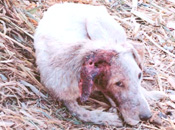 |
 |
| Pittston Animal Hospital |
4
O'Connell Street
Pittston PA. 18640
Office hours are
8:00a.m. to 8:00p.m. Mon thru
Fri
Call for appointment (570)
655-2412
|
|
|
 |
| Wilkes-Barre Animal Hospital |
<421
N. Pennsylvania Avenue
Wilkes-Barre, PA 18702
Business Hours are evening only:
8 p.m to 12 a.m. Mon thru
Fri
Please call us at (570) 821-9390
During business hours.
|
|
|
 |
| Tandojam Charity Animal
Hospital |
Mirpurkhas
Road,
Tandojam City Dist.
Hyderabad, Sindh, Pakistan
Phone 92 221 765442
|
|
|
|
 |
 |
 |
 |
| Dr. Inayatullah H. Kathio, D.V.M., of the
Pittston Animal Hospital and Wilkes-Barre Animal Hospital,
Inc. (Pennsylvania, United States), is a Fellow
and Research Officer/Consultant at the Food and Agriculture
Organization of the United Nations. He owns three animal hospitals
in Pakistan, which provide free services. |
|
|
|
 |
Two
Million New Cases Each Year
A
Veterinarian's Fight Against Leishmaniasis
By
Inayatullah H. Kathio |
|
 |
Focal
cluster of organisms of leishmaniasis
amostigotes Giemsa stain.
|
Even though the world's diverse nations
had united more than half a century
ago, the pace of dissemination of technology
is crawling. Today, a word can echo
all around the universe through satellites,
yet a simple parasitic disease goes
untreated in most areas of the world.
Global population is on the rise, as
are poverty and a deadly disfiguring
disease?leishmaniasis?which affects
humans and dogs and is transmitted by
the bite of hematophagous sandflies
(phlebotomies, owl midges).
According to the Journal of Clinical
Microbiology (May 2002), two million
new human cases occur each year and
at least 350 million people are exposed
to the risk of leishmania parasite infection.
Now veterinarians not only treat animal
diseases but have also become effective
sensors to alarm health authorities
in order to save the lives of animals
as well as humans. Rabies, tuberculosis,
Escherichia coli (E. coli) and leishmaniasis
are common diseases that veterinarians
diagnose and then alert health officials.
In existence for a very long time, leishmaniasis
is still affecting many children worldwide,
particularly in Pakistan. I have alerted
medical professionals that there still
is a great reservoir for leishmaniasis
of protozoa parasites among dogs, cats,
rodents and ground squirrels. Little
or no attention however has been given
to this disease, especially in remote
areas of Sindh, Pakistan, where people
are the victims of chronic poverty.
The World Health Organization (WHO)
appointed a handful of people to handle
an enormous and rapidly growing number
of leishmaniasis victims. The disease
in some cases is said to be self-limiting,
yet a sequela to the devastating disfiguration
of faces and limbs. A large number of
victims still live in places with dirt
roads and in dwellings without running
water or electricity. Many world bodies
and international and non-governmental
organizations are working to cope with
this disease.
 |
This
dog is lying on sugarcane straw
for comfort in a small town
in Pakistan. The ear shows pelodera
dermatitis and secondary infection.
|
Dogs are kept in villages not as pets
but for guarding livestock, policing
property and signalling intrusion by
a stranger. The majority of dogs in
Pakistan are scavengers, living on garbage,
bones and discarded food. However, no
data or record of incidence is available
regarding the prevalence of leishmaniasis
among these stray dogs. I recently recorded
ten dogs grossly affected with the cutaneous
form of leishmaniasis, and in some cases
they also suffered from secondary complications
of lymphoadenopahy, skin ulceration
and infection. It was also discovered
that households with dogs infected with
leishmaniasis also had children suffering
from the disease. A Board-certified
American human pathologist confirmed
impression smears from the lesions of
these children to be positive for leishmaniasis.
Dogs and cats have a large body volume
compared to rodents and squirrels, and
hence are easy targets for sandflies
to take a meal and then transmit the
disease to children. No effective drug
is being manufactured in Pakistan or
any developing country, so these drugs
have to be imported from Europe, possibly
through WHO. With the help of an already
financially unstable but supportive
Government, many veterinarians in Pakistan
can minimize the disease by reducing
the population of dogs and cats through
spay/neuter programmes. I have opened
three charity hospitals in the country
which offer free spaying and neutering
for these animals.
Very few people are able to avail themselves
of European-imported medications, and
even fewer are on weak and less effective
medications, such as metronidazole (anti-parasitic
drug), resulting in a large number of
children continuing to be victims of
this devastating disease. As veterinarians,
we can only minimize zoonotic diseases
by decreasing the population of animals
through a sterilization programme. Developing
countries should get support from WHO,
the United Nations and other international
organizations to manufacture the drugs,
which can be subsidized by the Government
and be made available to the ordinary
poor population.
|
|
|
|
|
|
 |
|
 |

